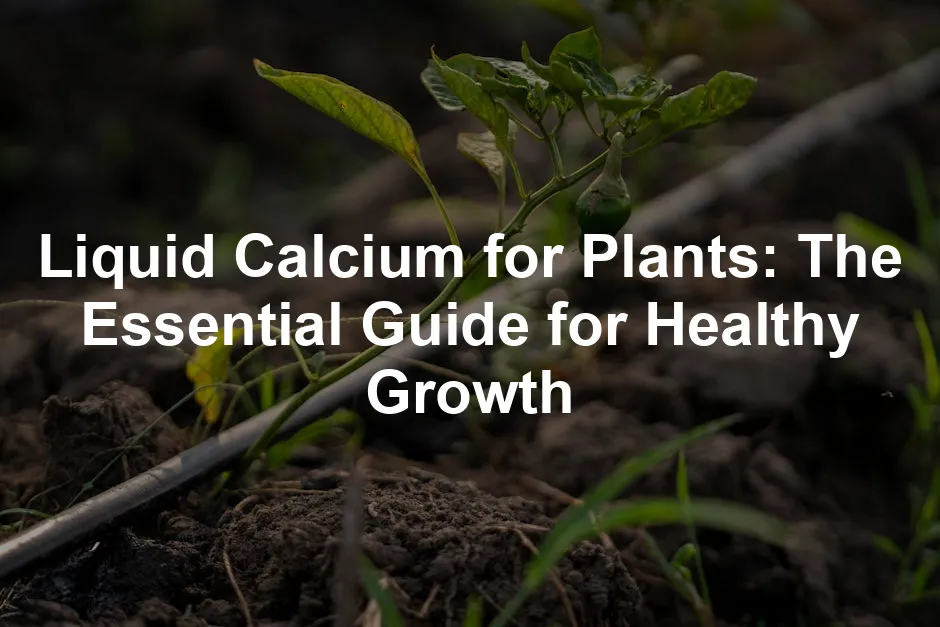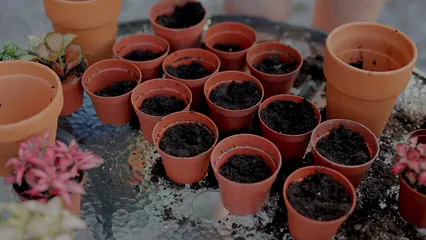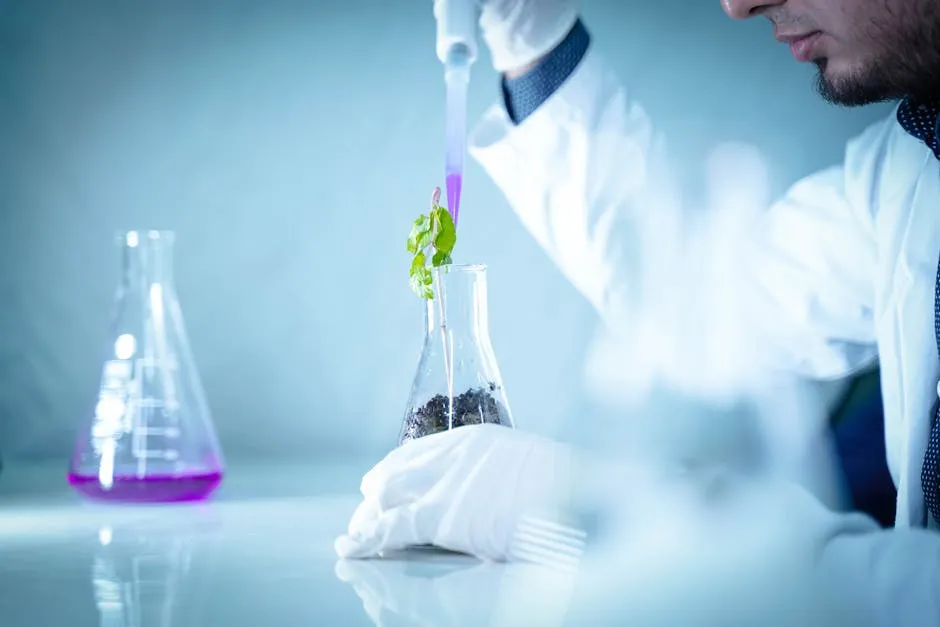

Liquid Calcium for Plants: The Essential Guide for Healthy Growth
Introduction
Calcium is crucial for healthy plant growth. It strengthens cell walls and supports various functions. Liquid calcium has gained popularity among gardeners and farmers alike. This fertilizer helps deliver calcium more efficiently, promoting vibrant, thriving plants.
And speaking of thriving plants, have you ever struggled with your soil’s pH levels? A Soil pH Test Kit can help you track those pesky acidity levels. It’s like a mood ring for your soil—only way less flashy and much more useful!

Summary and Overview
Liquid calcium is a concentrated solution providing easily absorbable calcium. Unlike traditional calcium sources, such as limestone, liquid forms dissolve quickly in soil, ensuring rapid nutrient uptake. This method benefits plants by preventing deficiencies and enhancing overall health. Its advantages include improved nutrient absorption, versatility in application methods, and the ability to correct calcium deficiencies swiftly. Understanding how calcium interacts with other nutrients in the soil is vital for optimal plant health and growth.
Don’t forget about proper gardening gear! A good pair of Gardening Gloves can save your hands from those inevitable prickles while you’re digging in the dirt. Trust me, your fingers will thank you!

Understanding Calcium’s Role in Plant Health
Calcium plays several essential roles in plant growth. It is a key player in cell wall structure, helping to maintain rigidity and strength. This nutrient also aids in the movement of other nutrients, ensuring plants receive what they need to thrive.
Calcium deficiency can lead to several symptoms, including yellowing leaves, stunted growth, and blossom end rot in tomatoes. Research shows that many crops require adequate calcium levels to produce high yields. For instance, tomatoes need around 0.3–0.5% calcium in their dry weight for optimal growth.
To ensure your plants are getting enough of this essential nutrient, consider using Organic Vegetable Gardening Book. It’s packed with advice on how to grow your veggies right and keep them healthy!
Testing your soil for calcium levels can help address deficiencies before they impact your plants. Regular soil tests are a proactive approach to maintaining soil health and ensuring your crops flourish.
Regular soil tests are essential for maintaining soil health and ensuring your crops flourish. composting basics for improving soil health

Why Choose Liquid Calcium Fertilizer?
Improved Nutrient Absorption
Liquid calcium fertilizers promote better nutrient absorption than granular forms. Unlike granules that need time to dissolve, liquid fertilizers provide immediate access to calcium. This quick availability enhances fertilizer efficiency and boosts bioavailability. As a result, plants can absorb nutrients more effectively, leading to healthier growth and improved yields. When you apply liquid calcium, you’re giving your plants a head start.
If you want to take your gardening to the next level, consider investing in a Hydroponic Garden Kit. It’s a fun way to grow plants without soil, and they’ll love the nutrient-rich water!

Versatile Application Methods
Liquid calcium can be applied in various ways, making it incredibly versatile. You can use foliar sprays, soil drenches, or even inject it through drip irrigation systems. This flexibility allows you to choose the best method for your plants and soil conditions. Plus, you can apply it at different times during the growing season, ensuring your plants receive calcium when they need it most. Whether you have a small garden or a large field, liquid calcium fits seamlessly into your routine.
And don’t forget to keep your tools in check! A reliable Garden Trowel is essential for digging, planting, and all those little tasks that require precision. It’s the Swiss Army knife of gardening tools!

Rapid Correction of Calcium Deficiencies
Calcium deficiencies can lead to serious problems like blossom end rot in tomatoes or tip burn in lettuce. Liquid calcium fertilizers address these issues quickly. When you notice symptoms of calcium deficiency, applying liquid calcium provides an immediate solution. Common plants affected by calcium problems include tomatoes, peppers, and apples. By correcting these deficiencies swiftly, you can enhance plant health and prevent further issues down the line.
Types of Liquid Calcium Fertilizers
Chelated Liquid Calcium
Chelated liquid calcium is a highly effective form of calcium fertilizer. It binds calcium ions with organic molecules. This process enhances calcium’s availability in the soil. One major advantage is its ability to improve soil pH. By doing so, it creates a more balanced environment for nutrient uptake.
When soil pH levels rise, nutrient availability increases as well. This means essential nutrients become more accessible to plants. Using chelated calcium can prevent nutrient deficiencies and promote healthy growth. If your soil struggles with acidity, this could be the solution you need.

Specialty Products (e.g., Pro-Cal, Advanced-Cal)
Several specialty products, like Pro-Cal and Advanced-Cal, stand out in the market. Pro-Cal offers a rapid source of calcium, addressing deficiencies effectively. It’s designed to combat low pH soil, which can hinder crop growth. Research shows it improves nutrient utilization significantly. You can find it here: Pro-Cal Liquid Calcium.
Advanced-Cal, on the other hand, combines chelated calcium with essential micronutrients. This unique blend helps enhance soil nutrition. It promotes vigorous plant development, making it ideal for various crops. Both products offer reliable calcium sources for gardeners and farmers seeking optimal results. Explore it here: Advanced-Cal Liquid Calcium.

Best Practices for Using Liquid Calcium
Using liquid calcium effectively can enhance your plants’ health. Here are some guidelines to ensure optimal results.
Application Guidelines
Start by diluting liquid calcium according to the product label. This ensures proper concentration for your plants. Aim for even coverage when applying to foliage or soil. A foliar spray works well for immediate absorption, while soil drenching ensures roots receive nutrients directly. A handy Foliar Spray Bottle can make this process a breeze!
Timing and Frequency
Timing is essential for maximizing benefits. Apply liquid calcium during critical growth stages. For most crops, a bi-weekly application during peak growth periods is effective. For fruiting plants, consider applying every 7-14 days to prevent deficiencies, especially when stress factors are present.
Integration with Other Fertilizers
Liquid calcium can be combined with other fertilizers. However, avoid mixing with those high in phosphorus, as they can react negatively. Use a compatibility chart or consult product guidelines. This approach will create a tailored fertilization strategy, enhancing overall nutrient uptake.

Potential Downsides and Considerations
While liquid calcium offers many benefits, understanding its limitations is crucial.
Common Misconceptions
Some believe liquid calcium can replace traditional sources entirely. In reality, it should supplement your regular calcium program, not replace it. Many products contain lower calcium content than solid alternatives, leading to misconceptions about their efficacy.
Drawbacks
Cost can be a concern, as liquid calcium tends to be pricier than traditional options. Additionally, over-application may lead to nutrient imbalances. Always follow the recommended rates on the product label to avoid this risk.
Evaluating Product Efficacy
To assess liquid calcium’s effectiveness, monitor your plants for signs of improvement. Look for healthier leaves and better fruit development. Soil tests can help determine if calcium levels are within the optimal range. Regular evaluations will guide your future fertilization strategies.

Conclusion
In summary, liquid calcium is a game-changer for plant health. It provides readily available calcium that enhances nutrient absorption, supports cell structure, and prevents deficiencies. Using this fertilizer can lead to stronger plants and improved yields. Consider incorporating liquid calcium into your fertilization plan for optimal results. By doing so, you’ll ensure your plants receive the essential nutrients they need to thrive, making it a valuable addition to your gardening toolkit.
FAQs
What is liquid calcium and how does it work for plants?
Liquid calcium is a concentrated solution that supplies easily absorbable calcium. It plays a vital role in plant nutrition by strengthening cell walls and facilitating nutrient movement. Unlike traditional sources, it dissolves quickly, ensuring rapid uptake by plants.
How often should I apply liquid calcium?
Application frequency depends on the crop type and growing conditions. For most crops, a bi-weekly application during peak growth stages works well. For fruiting plants, consider applying every 7-14 days to prevent deficiencies.
What are the signs of calcium deficiency in plants?
Symptoms of calcium deficiency include yellowing leaves, stunted growth, and issues like blossom end rot in tomatoes. Monitoring plants for these signs can help you take action before problems escalate.
Can I use liquid calcium with other fertilizers?
Yes, liquid calcium can be mixed with other nutrients. However, avoid combining it with high-phosphorus fertilizers to prevent negative reactions. Always check compatibility before mixing.
Is liquid calcium more effective than traditional calcium sources?
Liquid calcium provides quicker nutrient availability compared to traditional sources like limestone. While both have their advantages, liquid calcium is often more effective for rapid correction of deficiencies and improving plant health.
Please let us know what you think about our content by leaving a comment down below!
Thank you for reading till here 🙂
All images from Pexels



